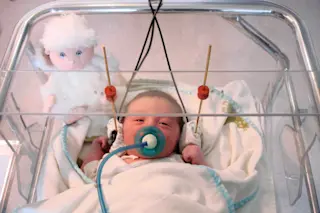We all begin existence as the simplest thing you can imagine if you’re trying to picture life: a single cell--nothing, in other words, but a tiny, spherical bag of proteins. In fact, the average one-celled amoeba looks far perkier under a microscope than a fertilized human egg. Yet that humble and nondescript appearance is highly deceptive. The egg, after all, boasts dazzling prospects, a future of truly dizzying--and until very recently, utterly baffling--complexity. When an amoeba divides, all you get is more amoebas. But when a human egg splits--first into 2, then 4, then 8, 16, 32, 64, and so on--it embarks on a venture that will, over the next nine months, produce descendant cells with a huge variety of shapes and functions: bone cells, nerve cells, red and white blood cells; the cells of the eyes, fingernails, stomach, and skin. Consider, for example, your body’s crowning glory, your head. How did the bone cells in your skull know enough to marshal themselves into a dome, while those in your jaw formed a trap-shaped mandible? And how did those on your left side arrange themselves in a mirror image of your right, and how were holes left in just the right places for your eyes? Come to think of it, how did your head wind up at the top of your body, nodding sagely at the end of your neck and spine? And that’s only the beginning. How did that bloblike egg give rise to, say, nerve cells in your fingertips with long filaments to cable signals back toward the spine? What informed them to relay their signals to intermediary nerve cells there by zapping them with chemicals? What told those cells’ filaments to twine themselves into a cord inside your spine, levitate toward your skull, and send messages into the folds of your brain for interpretation? For the better part of 200 years, since biology became a science, the process by which that one aboriginal cell carves out such brilliant and varied futures for its progeny has been an enigma--easy to observe, impossible to explain. But the knot has begun to untangle, thanks to two big breaks. The first of these was the discovery in 1953 of the structure of DNA, the genetic blueprint at the core of our cells. That led to quick progress in understanding how genes might direct the growth and fate of cells in a developing embryo. The second big break came much more recently. Because research on human embryos presents both ethical and scientific difficulties, biologists have done most of their work on rather simple organisms: roundworms, leeches, fruit flies, frogs. But it was by no means a given that the early life of a worm or a fly really offered any insights into humans. Then, in 1984, biologists working with fruit flies found a bit of DNA they called the homeobox. The homeobox got its name because it first surfaced as a leitmotif in homeotic genes--those known to specify body-part formation. (One of them, if it mutates, plunks legs on a fly’s head where its antennae are supposed to be.) These homeotic genes were known to be gathered together in clusters on a strand of DNA, arranged in a sequence that uncannily mimics the order of the body parts in the finished fly. For example, the genes in one cluster control the design and fabrication of the fly’s head and upper thorax; the genes in the next cluster down the line define the fly’s lower thorax and abdomen. Researchers found that in every one of these body-forming genes this one stretch of DNA--the homeobox--was the same. So what? you might ask. Some biologists were similarly unimpressed, until the homeobox began turning up in development-related genes in all kinds of other creatures: worms, African clawed frogs, mice-- and humans. Its recurrence in animals all the way from the low-rent basement of evolution right up to the penthouse suggested that the homeobox was no mere curio but something crucial to development in a vast array of living things. Indeed, by 1990 it was clear that the homeobox was part of a basic genetic switch, turning on (whenever it’s appropriate) other genes in the cascade of events by which initially featureless cells are trained for the thousands of different roles they’ll eventually assume. William McGinnis, a molecular biologist at Yale, found he could even transplant homeobox-containing genes from a mouse or a human to a fruit fly and have the genes work. So the study of worms and flies no longer seemed a blind alley, but rather a royal road to the secrets of morphogenesis. We were excited when it turned out the same genes were being used both in flies and in vertebrates, recalls Edward Lewis, a geneticist at Caltech and one of the pioneers of the field. That made it a globally interesting subject. Evolution, after all, has rearranged a lot of genes to get from arthropod to anthropoid, and they tend to get scrambled So what? you might ask. Some biologists were similarly unimpressed, until the homeobox began turning up in development-related genes in all kinds of other creatures: worms, African clawed frogs, mice-- and humans. Its recurrence in animals all the way from the low-rent basement of evolution right up to the penthouse suggested that the homeobox was no mere curio but something crucial to development in a vast array of living things. Indeed, by 1990 it was clear that the homeobox was part of a basic genetic switch, turning on (whenever it’s appropriate) other genes in the cascade of events by which initially featureless cells are trained for the thousands of different roles they’ll eventually assume. William McGinnis, a molecular biologist at Yale, found he could even transplant homeobox-containing genes from a mouse or a human to a fruit fly and have the genes work. So the study of worms and flies no longer seemed a blind alley, but rather a royal road to the secrets of morphogenesis. We were excited when it turned out the same genes were being used both in flies and in vertebrates, recalls Edward Lewis, a geneticist at Caltech and one of the pioneers of the field. That made it a globally interesting subject. Evolution, after all, has rearranged a lot of genes to get from arthropod to anthropoid, and they tend to get scrambled in the process. But that apparently hasn’t happened with the genetic building blocks that govern development; the homeobox, the genes in which it occurs, and even the order of those genes along the DNA strand have remained remarkably constant. It was all invented only once, Lewis says, stressing the uniqueness of the phenomenon. Virtually no other gene cluster has survived a half-billion years. Why should the genes responsible for development stay whole as they tread the rocky course of evolution, while other genes have been torn apart and reassembled like so many Lego blocks? McGinnis offers a tentative answer. When you look at a fly and a mouse, he says, they’re obviously different. But their fundamental body plan is similar: they have the same head-to-tail organization. The genes that control ‘headness’ and ‘tailness’ evolved eons ago, either because the plan was so good or by accident. What works for flies also works for us, as evidenced in a pair of cartoons displayed prominently in Lewis’s lab. The cartoons serve as a quick antidote to an overdose of anthropocentrism: some of the same genes that distinguish the fly’s lumpy head from its thorax help distinguish our shapely craniums from our eminently desirable torsos. Humans and flies are very similar in organization, Lewis concludes. They both have a head, thorax, and abdomen because that seems to be the most sensible and efficient form. Why would evolution invent all these things over again? To see how these developmental genes might work to turn an egg into a finished creature, we need to go back to that single lowly but ambitious cell you started out as. Within it, of course, there lurked a powerful hidden resource--a complete copy of your DNA, an inherited trust fund of roughly 100,000 genes with a potentially immense repertory of cell- building functions. These genes are the real secret to a cell’s body- building talents. Once turned on, they produce proteins, which are capable of building new cells and modifying them in any number of ways. Genes can force a cell to sprout new structures, like the branched filaments of a nerve cell. Or they can induce it to spew out proteins that float over to talk to neighboring cells, or that interact with DNA to turn on another, heretofore quiescent gene. In fact, the awe-inspiring cellular changes needed to turn you from microscopic blob to prepossessing bipedal adult are controlled by the orchestration of a whole slew of genes. Once you realize how much complexity there is in a single cell, Lewis observes, the complicated body structure you see in higher organisms isn’t that surprising. Each cell in a higher organism tends to be only a specialization of the basic cell that could originally do everything, he says. However, not all the developmental genes in your DNA legacy function all the time; they act only when turned on. Once you’ve grasped that idea, one aspect of the mystery of development isn’t particularly arcane. Silent genes in your cells can be switched on; active ones can be shut off. Such genes, stimulated or deactivated, can produce or repress proteins that alter both the shape and the behavior of each cell. Turn on one combination from among your 100,000 genes and the cell will become a brain neuron; turn on another combination and it becomes a bone cell in your fingertip. And if the genetic switches get stuck in their new positions, the changes become irreversible, and the cell’s descendants inherit them, retaining those newly acquired characteristics indefinitely. That’s a relief; after all, you wouldn’t want the gray matter in your head to turn to bone overnight. But what starts this process going in the first place? One answer came as early as 1905, when Edwin Grant Conklin, an American biologist working with a small marine creature called a tunicate, made a striking observation. The contents of the tunicate egg, Conklin discovered, weren’t uniform. Different parts of it were differently colored. When the mother egg began to divide, the new daughter cells, naturally enough, took their cellular matter from the part of the egg from which they’d arisen. What surprised Conklin, however, was that the daughter cells that came from different-colored areas became--as they split away--different types of tissue. The yellow stuff in the egg produced muscle cells, for instance, and the grayish stuff became the gut. Some substance--a different one, presumably, in each part of the egg--was acting to shunt each daughter cell down a different developmental path. Later experiments confirmed that different parts of the egg can indeed dictate the fate of their descendant cells by using proteins to activate (or deactivate) the relevant developmental genes. There’s a handy model for this type of development in a sleek, threadlike worm about .04 inch long, with the nearly unpronounceable name Caenorhabditis elegans. When a C. elegans egg splits in two, the resulting forward cell is visibly larger than the one behind, and its descendant cells develop differently from those of its smaller sibling. You can squash one of the two original daughter cells so it dies, or take a needle and remove one of them, explains Robert Horvitz, a biologist at MIT who’s studied C. elegans extensively. But if you do, he points out, the pattern you observe in the remaining cell’s descendants doesn’t change. That means they must be responding to something in the egg--they can’t possibly be responding to signals from the removed cell, which is the only other possibility. In other words, strategically located proteins from the mother egg must be turning the cells’ developmental genes on and off. That’s an efficient start-up program, but it doesn’t work so well further along the developmental pathway. By the time, say, a human embryo’s eyes begin to take on their final shape, the egg is long gone and the cells have migrated a far piece indeed from where their ancestors started out. How do these cells learn what shape and position they ought to assume in the body? If you have a cell that has to learn its positional identity in a growing field of cells, McGinnis comments, chances are it’s getting its orders from the cells in that growing field. In other words, at this stage, to develop properly in the body, a cell needs to be in constant communication with its neighbors. Isolate it from their informational chatter and it’s lost. C. elegans illustrates this point after its first two cells divide into a cluster of four. The cell at the front of the embryo normally divides to begin producing the muscles of the worm’s mouth. But you can radically change its destiny by removing one of the cells next door to it. You can make a little hole in the shell of the egg, Horvitz explains, then press on it with a cover slip, squishing it until the cell pops out. Do this, and the daughters and heirs of the front cell fail to form the worm’s mouth. Apparently some signal from the front cell’s neighbor is necessary to switch on the appropriate genes. So the prod to the genes that shove a hesitant cell down a particular pathway can come either from inside the egg or, once the embryo gets going, from its neighboring cells. The mechanism is simple, but as more and more cells appear in the embryo, the signals can become symphonically complex--a near-infinite cascade. That’s what ultimately pushes an initially indecisive adolescent cell with all the world before it into an active career secreting insulin, say, in your pancreas, or a life of easy retirement in your appendix. Nature turns an uncomplicated act of choice into a generator of vast complexity by throwing a long succession of switches, each of which makes a simple either-or choice for a cell and all its descendants. But since there are thousands of switches that can be thrown in different sequences, there are many millions of potential choices of structure and function available to an organism of any complexity. It’s easy now to picture how an aspiring fertilized egg ultimately turns into a frog or a fly. The egg comes equipped with different proteins in its different zones. As it divides, the daughter cells are directed--via their developmental genes--down different paths, depending on what part of the egg they took their substance from. It’s as if a unique protein in one section of the egg tells all the cells formed there, You be a front cell, or You’re a back cell. Then, as cell division progresses and more and more cells populate the embryo, they begin chattering chemically to each other, specifying more and more complicated information about shape, function, and position. A cell destined to form a foot, for example, might send a message to a neighboring cell directing its descendants to switch on genes that direct the cells outward and shape them into a leg. What’s more, as embryos develop, their tissues shift around in relation to one another. That means cells can receive new signals as new tissues move within their protein-signaling range. It’s a bit like biological astrology: as tissues slowly cycle through the embryo, they can fall under the sway of new influences, and their fates swerve accordingly. In a complex creature like a human, this process can take some strange turns. Take the case of the lens of the eye. In the 1960s, research on amphibians showed that the highly specialized cells that form the lens acquire their distinctive shape only after a series of elaborate migrations. Their earliest distinct identity is as skin cells, positioned in the embryo above a group of cells destined to become the pharynx. But gradually some future heart tissue drifts within range, and it sends another series of developmental cues vital to lens formation. Only later do the future lens cells come into contact with anything you’d intuitively connect with an eye: the maturing retina, which apparently sends the final barrage of messages that complete the transformation of these cells into a lens. (As it happens, some of the cells in the lens of your eye are the very same cells that were laid down shortly after you were a fertilized egg. They were never replaced. As you read this page, you are, so to speak, looking through your own embryo.) You can see the whole developmental megillah--from egg to body-- neatly illustrated in the Model T organism of genetic research: Drosophila, the common fruit fly. Shortly after fertilization the cells of the future fly grub begin making their fateful choices. From the mother, the egg inherits instructions to make a protein called bicoid, which spreads through the egg in a smooth gradient, concentrated heavily at the front of the egg and gradually thinning out toward the rear. The high density of bicoid clearly marks the front of the embryo; it also trips a class of genes called gap genes that further define the thorax and abdomen. This takes about two and a half hours and amounts to a preliminary laying out of the construction site--determining what’s fore and what’s aft. Then the next step begins. Triggered by gap genes, another set of genes (including one named hairy) causes the embryo to display a zebralike pattern of seven stripes. That in turn sets the stage for the division of the embryo into 14 segments, under the auspices of a gene named engrailed. The fore-and-aft theme, so far a sweeping motif affecting the whole embryo, is replayed in each of the 14 segments that now appear, and a fascinating collaboration commences between engrailed and another gene, called wingless. Steve DiNardo’s busy, fly-filled laboratory at Rockefeller University in New York has been the scene of some experiments that illustrate this collaboration quite dramatically. According to DiNardo, as each segment begins to display boundaries, engrailed and wingless start signaling to each other with proteins that encourage each gene in its designated task. As a result, engrailed starts telling the cells in which it’s expressed to form the rear of the segment. In a line of cells just ahead of the engrailed cells, wingless is ordering its cells to draw a sharp line offsetting the segment’s back from its middle and front. This synergy shows up dramatically if you douse the embryo with an indigo stain attracted to wingless and a yellow stain that seeks out engrailed. The almost militarily exact line of wingless cells at the front of each segment shows up deep blue; the equally firm engrailed line behind it is yellow. Interesting, but how do biologists know it’s a protein signal produced by the wingless gene that keeps engrailed activated in nearby cells? An ingenious experiment proves it. The wingless gene occurs in a mutated form that’s temperature-sensitive, DiNardo explains, meaning that you can shut the gene off by raising the temperature. If that’s done, the engrailed genes in the neighboring cells can’t stay on and the cells fail to take up their normal positions. More intriguing still, it appears that these engrailed-expressing cells can in turn trigger a chain reaction in the rows of cells behind them, each row acquiring slightly different characteristics. This shows up dramatically in a series of barbs that sprout from engrailed-expressing cells and their immediate neighbors on the grub’s underside. (They’re called denticles; eventually the grub will use them to crawl around.) Each barb is slightly different in shape and position--suggesting a relay of signals from cell to cell, with each cell slightly modifying the signal that it passes on to its neighbor. All segments, however, do not develop in the same way. Those in the grub’s thorax are distinct from those in its abdomen, with much daintier denticles. Their differences foreshadow the dramatic distinctions evident when the grub grows up to be a full-fledged fly--the fly’s thoracic segments will wear wings and legs, while the abdominal segments will wear neither. All these structural differences are achieved by the homeotic genes that are so vital to development. Recall the poor mixed-up fly with legs where its antennae should be. That’s what happens when a homeotic gene for a leg-bearing thoracic segment gets wrongly expressed in the head. You can get an equally bizarre result by mutating another gene for a thoracic segment. The fly winds up as a sort of biplane with a double set of wings. Of course, it’s a long stretch from a grub’s creepy denticles or a fly’s wings to, say, the human brain, with its estimated inventory of 100 billion interconnecting neurons. The problem becomes even more daunting when you consider that there’s a huge number of different kinds of neurons and they’ve never been fully characterized. But in principle, even the emergence of a hugely complex structure like the brain isn’t so baffling. It’s simply a matter of putting one foot in front of the other. Imagine a series of cells, each choosing a different route in a garden of forking paths, until among them they’ve gone on to millions of different destinations yet stayed in communication with one another. Voilà, the primate brain. Simple? Sort of. The broad outlines of development seem clear, and a number of steps have been described in convincing models. The egg contains a protein that switches on the genes that switch on other genes that make the proteins that do the work that turns the simple egg into the complex adult. But there’s still plenty of mystery left. Nobody’s yet quite sure, for instance, how the genes and proteins in the later part of the cascade actually build the branching axons on your nerve cells, or the dense thicket of fibers that make up the lens of your eye, or the articulated stem of your spine. In fact these effector genes (as opposed to regulator genes) are unknown. In other words, the genetic architects of development are becoming known, but the actual hands-on builders remain strictly incognito. It’s sometimes called the downstream gene problem, McGinnis admits, because you need some blue-collar genes to actually do the work for these executives. But where or who are those guys? That’s a mighty tough question because biologists are only beginning to figure out techniques for finding them. It’s as if they’d just glimpsed the Guggenheim Museum and were trying to learn how it was built. They’ve admired the simplicity of the bold white spiral, pored over the drawings of Frank Lloyd Wright. But the hands that transformed his vision into concrete and steel are nowhere to be found.
How Does a Single Cell Become a Whole Body?
It remains one of biology's deepest enigmas. How does an egg, a tiny squishy blob of a cell, grow into a fully formed organism--a sinuous worm, a delicate fly, a perfect human baby?
More on Discover
Stay Curious
SubscribeTo The Magazine
Save up to 40% off the cover price when you subscribe to Discover magazine.
Subscribe











